Rose Himalayan musk. A true master and mistress of a luxurious collection of roses. Musk roses: care
For the opportunity to admire musky hybrids today, we must thank the Belgian nursery Lens. Three generations of rose growers were at the head of the famous house. The last of them, Louis Lens (1924-2001), was engaged in the selection of musk hybrids for almost half a century. Perhaps this is how the company searched and found its niche in the world of fierce competition among rose producers. Although, without the dream that every originator strives for, such long-term enthusiasm is impossible.
Musk rose scent
Few of our gardens contain the once ubiquitous bed of pink, uncluttered by messy ground cover, with evenly distributed, pruned rose bushes, providing a rag bag of color for three or four months of the year; then nothing.
These days, shrub roses are something that is often included in a relaxed planting area. But given the overwhelming choice bush roses, which will put on the best show and give the biggest reward for the inevitable time spent on them? The "old ones", often rejoicing in fantastic French names, sell out too quickly, and the modern ones, despite their very complex genealogy, often disappoint, with flowers too heavy and scent too weak.
Louis Lens - King of Musk Roses
Louis Lens began his first work on hybridizing roses in 1956, and today his work is continued by Rudy and Anne Vehl-Budolf. The nursery's assortment includes about 800 varieties.
Belgium appreciates the merits of Louis Lens; the book “Louis Lens - Elegance and Rose”, written by a well-known Belgian journalist and expert, is dedicated to him garden plants Ivo Pauwels (Louis Lens - De Elegantie en de Roos). This is a tribute to the breeder who created a beautiful rose history on Belgian soil.
In my opinion, every garden should have at least one hybrid musk. They are without exception vigorous and healthy, with open, bushy growth and clustered flowers that look softly old-fashioned but still manage to hold their heads up. Given their attributes, hybrid musks may have been bred specifically for modern gardens, but they, surprisingly, have been with us for quite a long time. There are only a few dozen, most of which were raised in the first 30 years of the last century by the village priest, the Rev. Joseph Pemberton, who had a passion for roses and time on his hands between sermons.
Striving for perfect rose, Lens created a garden not only for devoted fans of roses, interested botanists, but also simply for lovers of everything tender and beautiful.
Best memory of Louis Lens
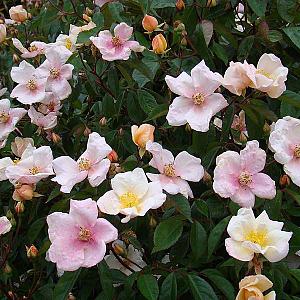 "Souvenir de Louis Lens"
"Souvenir de Louis Lens"
It is these Pemberton roses, as they are often called, that captivate me the most. 'Prosperity', white with a stronger scent, seems to light up an even brighter display of flowers, while the smaller flowers of loose 'Cornelia', a pale, dusty apricot-pink in the summer, take on a darker hue as temperatures and autumn level in autumn.
Of all the hybrid muses, however, it is probably "Buff Beauty" that receives the most attention and the most praise. Turquoise hybrid roses musk available upon request. Personal shoppers can purchase hybrid musks in containers. Potted roses are available throughout most of the year, but because they do not have a secure root ball, you must take extra care if you plant them while they are producing growth. Give hybrid musk roses plenty of space - they are at their best if they are allowed to become intrusive. "Buy beauty" and more large varieties can be trained as climbers and are ideal for spaces too small to accommodate a true climbing rose. Hybrid muskflowers grow on new growth, so some pruning and tidying up in late winter is beneficial. This involves removing large old shoots from the base of the rose every few years, which may require thin pruning with a saw, as well as annually removing old hips and weak, crossing shoots from the bush. This will result in a burst of growth and a late flush of flowers that is even good or even better than the first. Mildew and black spot can be a problem if growth becomes overcrowded, especially if the roses are covered with herbaceous and other plantings. 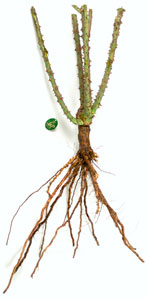
- Organic mulch and pelleted feed should be used during this time.
- Apply pink poop at the same time.
Why was this particular variety chosen in memory of the great originator? I think the answer lies in the choice of the parenting pair. This rose takes us back to the roots, to the climbing form of the variety "Trier" (1904), developed by the German gardener from Trier Peter Lambert. "Trier" was widely used in gardens due to its numerous flowers, iridescent color and hardiness.
Fill the hole with two-thirds of the remaining soil mixed with peat moss or compost. Press your hands firmly. Add water, let it soak in, then finish filling the hole with soil. Press the lamp lightly and ventilate well. Spread mulch, compost or bark around the plant to suppress weed growth and conserve moisture. Water 3 - 4 times a week until the leaves begin to grow.
Your plants will fall out faster if you extinguish the canes as often as possible while they start to work. Roses need adequate moisture, both above and below the soil, to fully develop. First Year Bloom, Butterfly Lovers, Flower, Fragrance, Long Bloomers.
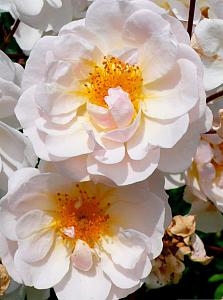 "Trier". Opens a modern group of musk rose hybrids
"Trier". Opens a modern group of musk rose hybrids
Musk roses: reviews from owners
Beds, Borders, Decorative, Outdoor, Wine and Climbers. Canada, Guam, Hawaii, Puerto Rico, Virgin Islands. Have you been browsing through your favorite gardening catalog or website looking for new roses to plant in your garden and wondering if it would be better to choose barerota roses or those from nurseries? If you're like gardeners, this question has come up at some point. And we want to help you find the answer to what's best for you and your garden.

Own root roses are developed by cutting from an existing plant and then planted directly into the soil. This type of rose is the same variety above and below the ground. Easy to plant, usually firmer in cold climates, and can produce more shoots and flowers for variety than if they were traditionally grafted or loosened.
This rose is still grown in some nurseries in Europe and the USA and is sometimes sold under the commercial name "Moonlight". Not every lover in Russia can see this variety in the garden, but many are familiar with another famous variety of this originator. This is "Mozart" (Lambert, 1936).
Predecessors worthy of respect
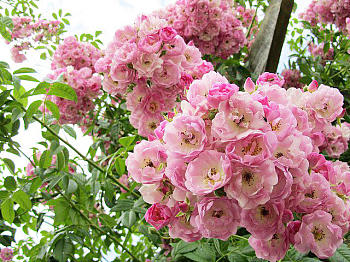 "Ballerina"
"Ballerina"
Barerot roses will have brown roots and dormant stems when they arrive. Plants that do this actually have the advantage that they can focus their energy on a strong root development rather than supporting extensive leaf growth during planting.
Uses of musk roses
You can plant your barerots or your own roots earlier in the growing season since there are no leaves to be deadened by frost. They can usually be planted as early as six weeks in advance because they don't need water applied to the leaves or flowers and usually set quickly.
The modern group of musk rose hybrids (Hybrid Musk.) begins with the variety "Trier", although at first Peter Lambert called a series of his varieties with similar characteristics Lambertianas (Lambertian).
Later, Lambert roses were used in hybridization by the English vicar Joseph Pemberton, and he called his series musk roses, which gave the name to the group modern roses. The most famous varieties Pemberton selections: "Felicia" (1926), "Cornelia" (1925), "Daphne" (1912).
Container roses should generally be planted in late spring and fall. They are easy to plant and provide instant gratification as they do not sleep and will have buds within a few short weeks, if they don't show up when they arrive. They are also ideal for replanting in decorative containers and make an attractive gift. All our potted roses are native root unless otherwise noted.
As you can see, there are benefits to both bariott and container roses, so depending on what you decide is best for your garden, we are confident you will become a lover for life, if you haven't already ! Star in Southern California.
Pemberton's follower, Jack Bentall, developed one of the most famous varieties, "Ballerina" (1937). This "wonderful gift in the form huge amount flowers still inspire awe,” says English breeder Philip Harkness.
The most devoted follower of Lambert and Pemberton turned out to be Louis Lens, who bred about 100 varieties. The most famous of them: "Sibelius" (1984) "Pink Magic" (1990), "Bouquet Parfait" (1989), "Frais" (1990), "Feeling" (1992), "Guirlande d'Amour" (1993) , "Rosalita" (1997)
Anyone can grow roses - all you need is a place with 6 hours of sun a day. Roses even work well in containers, so you have no excuse for not having a garden! If you are planting carob roses, first wash the roots in warm water within 12-24 hours. If you can't plant your roses right away, you can leave them in their boxes for up to a week in a cool, dark place. Be sure to sprinkle water on the roots every few days.
Difference between Jackson and Perkins
Dig a hole about 12 inches wide by 24 inches wide. Make sure it is large enough to give the plant's root system plenty of room to develop after planting. Loosen the soil at the bottom and sides with a shovel.
Raised in California by the best rose professionals in the world
California provides some of the best pink plants in the world. All our roses are grown in soil that has been tested and analyzed to ensure they are grown to the exact levels of essential essentials. nutrients.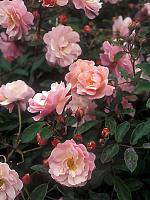 "Cornelia"
"Cornelia"
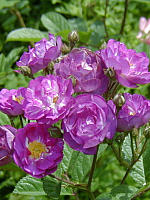 "Sibelius"
"Sibelius"
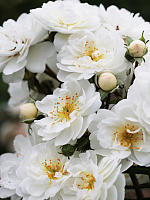 "Guirlande d'Amour"
"Guirlande d'Amour"
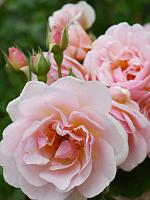 "Felicia"
"Felicia"
The history of musk roses
Appropriate amounts of fertilizer, water and nutrients are then added to the roses during their active growth cycle by our experienced rose growers. Each rose is hand selected and prepared by experienced professional rose growers.
Exclusive and superior rose breeding process
All this tender loving care under the generous California sun results in young yet vigorous growing growth with a root system that is ready to bloom quickly in your rose garden. Exclusive pink varieties Jackson and Perkins were bred to demonstrate the most preferred characteristics of roses for gardeners. One rose variety takes many years to develop, and our breeder breeders carefully evaluate, test and cultivate superior new genetic traits in these new rose varieties for introduction.
That's how it happens
The contribution of Louis Lens to the selection of roses cannot be overestimated, but the glory of world recognition went not to a professional, but to an amateur enthusiast Holmes from Great Britain. The musky hybrid "Sally Holmes" (Holmes, 1976), a descendant of the variety "Ballerina" and the white floribunda "Ivory Fashion" (Boerner, 1958), was inducted into the Hall of Fame of the World Federation of Rose Growers in 2012. This rose became exhibit No. 15 there. All its charm is difficult to convey in words.
Now healthy pink plant canes tend to clients' garden performances. The roses are then harvested at the ideal time in preparation for shipping and customer planting. If this is the first time you've planted bareroot, you may be surprised by their brown roots and dormant stem. However naked root roses provide the simplest and quick way planting roses without worrying about replanting.
Bare root roses may appear dead upon arrival, but the plants actually have the advantage that they can focus their energy on strong root development rather than maintaining extensive and stressful leaf growth immediately after planting. Bare root roses - best option for planting at the beginning of the season. In fact, late winter - best time for landing. Our bare root roses are fully established plants that meet the highest industry standards. They come dormant, making them ideal for planting.
 "Sally Holmes"
"Sally Holmes"
Musk - the scent of bliss
Musk is a substance produced by the glands of some animals (musk deer, beaver, etc.) or found in the roots of some plants and used in perfumery.
It gained particular popularity in the Middle East, where black musk is considered the most masculine scent, it is sharp, tart, persistent. In large concentrations, the specific smell of musk is quite pungent and unpleasant, but with large dilutions, the smell becomes sensual and bewitching.
Musk roses of Lens
The roots penetrate into the native soil rather than packed soil. Of course, since they aren't in the soil when you get them, there shouldn't be a mess with them. You may want to plant your bare root roses earlier in the growing season since there are no leaves to get frost damage. They can usually be planted as early as six weeks before spring and spring will not be more than two weeks after this average date. But because they don't have to provide water to the leaves or flowers, they usually set up faster than those that come in containers.
What can you compare the smell of musk to? Some say it has a floral honey note with hints of fruit and clove. To choose a standard for yourself, you still need to smell the most fragrant musk roses.
Perfumers have discovered that musk not only brings a completely new note to perfume, but it also turns out to be good fixative odors of other aromatic substances. The durability, richness and attractiveness of perfumes containing musk have increased significantly (by the way, so has their price).
Charles Baudelaire said about such perfumes that the presence of musk in them makes their smell “rich and conquering.” There is a legend that there was a mosque in Tabriz, the walls of which were laid in lime mortar with the addition of musk, the smell of which could be felt even several centuries later.
For the sake of the aroma...
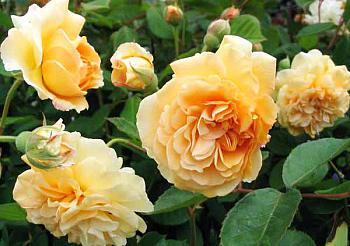 "Buff Beauty" One of the most fragrant musky hybrids.
"Buff Beauty" One of the most fragrant musky hybrids.
But unfortunately, some roses from the group of musk hybrids have no scent at all. Aroma is a complex breeding trait; it is not necessarily inherited, and the originators in this matter still rely on their experience, intuition and chance.
...And other advantages
What else is attractive about musky hybrids besides the smell? First of all, fantastic abundant flowering. In large racemose inflorescences there are sometimes up to 40-50 buds, which, when blooming, form a continuous cover of flowers that lasts for weeks. The mystery of such abundance lies in the nature of growth and flowering. On the main shoot, lateral buds quickly germinate and form an inflorescence, which is why flowering does not end at the top of the main shoot, but descends from top to bottom.
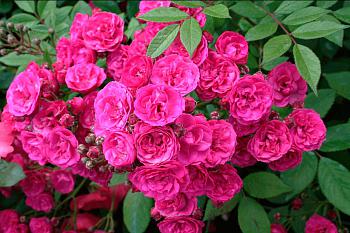 Inflorescence, like a whole bouquet. Variety "Dinky"
Inflorescence, like a whole bouquet. Variety "Dinky"
The color of the flowers is often delicate, apricot-yellow, pink, cream, iridescent, although red and even purple are also found.
The attractive shape of the bush is another plus
Along with the abundance of flowering, musk hybrids are distinguished by their attractive habit. They often form voluminous, wide bushes up to 1.5-1.8 m high with gracefully drooping tops, although there are varieties with compact growth.
Catalogs usually indicate the minimum height of the plant, but some hobbyists are proud of their huge bushes. I advise you to correct the habit with light pruning and achieve maximum attractiveness of the appearance.
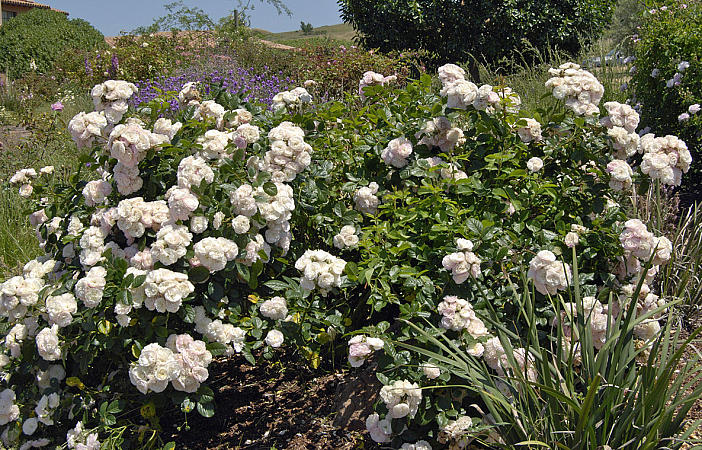 "Bouquet Parfait"
"Bouquet Parfait"
Sustainability - yes! But...
As in every garden group, there are relatively unpretentious varieties, capable of growing in poor soils and tolerating partial shade, but for the most part they, like other roses, require attention.
In conditions similar to the Moscow region, roses need shelter for the winter, and some varieties require high hilling. In colder areas, even the hardiest roses have to struggle to survive.
You should not believe advertising and hope that all varieties are not susceptible to fungal diseases. If dense bushes are poorly ventilated, then at the end of summer there may be problems with powdery mildew. Some varieties are also vulnerable to black spot.
Placement in the garden is not an easy task
 "Guirlande d'Amour"
"Guirlande d'Amour"
I would not undertake to collect and place a large collection of musk hybrids without compromising the design, although two or three roses will decorate any garden.
From the Lens selection, I chose three varieties for myself, although in the collection we have been maintaining several old varieties and even a specific musk rose for many years. My choice: "Guirlande d'Amour" (1993), "Jean Stephenne" (2006), "Hedi Grimm" (2006) and I dream about "Souvenir de Louis Lens" (2011).
We cut carefully
Musk hybrids do not like (and sometimes cannot tolerate) short pruning. Watch the base of the bush; if there are no replacement shoots, and the bush is bare below, then with short pruning in the spring, the rose (for example, "Mozart") may die. In general, light or only sanitary pruning is practiced with musk hybrids. With the appearance of replacement shoots, some of the old shoots can be removed completely.
Important for musk hybrids summer pruning. Faded inflorescences must be trimmed regularly, otherwise the onset of the next wave will be delayed, and the bushes will look neglected.
You can leave a few inflorescences for fruit set, although musky hybrids are not famous for their decorative fruits.
Not at first sight
 "Mozart
"Mozart
In the very first years I came across "Ballerina" (1937), "Robin Hood" (Pemberton, 1927), "Mozart" (Lambert, 1937), "Dirigent" (Tantau, 1956).
Today I’m even ashamed to admit that these acquisitions (with the exception of “Mozart”) disappointed me, to put it mildly. I was surprised by the abundance of flowers, but I didn’t see the beauty simple flower, I was fascinated by classical terry varieties. Today, of course, I see that simplicity does not exclude beauty and elegance, and the natural nobility of a flower only adds charm.
My favorite variety
It's hard to choose a favorite rose from a thousand varieties, but I put "Guirlande d'Amour" in the top 10. "Guirlande d'Amour" (Lens, 1993), ADR-2012, h=2.5. This modern hybrid of musk roses has already conquered Europe, received several high awards and ADR certificate. The flowers are small, double (up to 40 petals), snow-white with tiny bouquets of stamens. The inflorescences are very large, suitable for cutting. The aroma is quite strong, slightly spicy.
From musk roses "Guirlande d'Amour" inherited an almost continuous flowering pattern, from the upper tiers to the lower ones. The foliage is decorative, dense, matte, healthy. Not demanding on growing conditions, tolerates partial shade. Can be grown on any support or in the form of a scrub, this The rose will decorate any garden. The best recommendations.
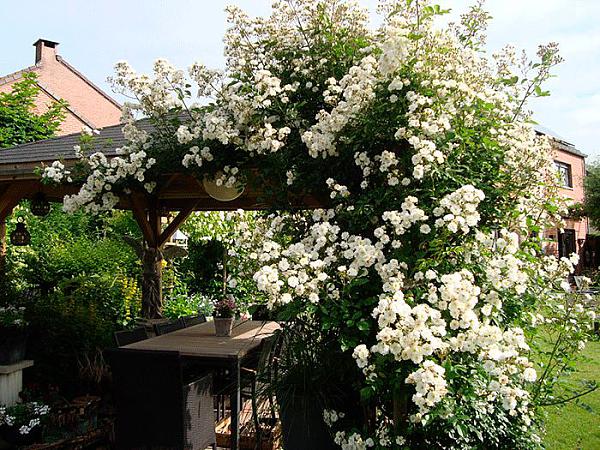 "Guirlande d'Amour". Can you remain indifferent?
"Guirlande d'Amour". Can you remain indifferent?
If you want to form "Guirlande d" Amour" as a climbing form, form it on a support, guide and tie up the main shoots as they grow, and later (after pruning) you need to select the strongest side branch and also direct it vertically and tie it up. If allow natural growth, the rose quickly forms a voluminous, free-form bush.
| Gravin Michel d'Ursel |
A little history
A number of hybrids are called musk roses - Rosa moschata, Rosa multiflora, Rosa phoenecia, "Nastarana", Rosa mulliganii, Rosa sempervirens and Rosa arvensis. Their history begins in 1904, when the German breeder Peter Lambert developed the Trier variety, which is considered the ancestor of the class. We owe to Lambert the appearance of one of the best musky varieties - Mozart. The Englishman Joseph Pemberton (he bred such famous varieties as Cornelia, Felicia, Nur Mahal, Penelope, Prosperity), his followers Anne and Jack Bentall (authors of the famous Ballerina and Buff Beauty), as well as the Belgian Louis Lens, who widely used r. moschata and other hybrids that are little used in breeding (for example, r. filipes) in their breeding programs. Currently, the Lens Rosen nursery continues to work in this direction, and offers a lot of very beautiful varieties: green-pink Alden Biesen, chic Bouquet Parfait, climbing Guirlande d’Amour and Guirlande Rose, unusually abundant Heavenly Pink, Sibelius, Dinky. Roses from this nursery are not yet supplied to us, but I hope the situation will change in the near future.
Unfortunately, the varieties of this group are not very common and, apart from a few of the most popular, are almost unknown in our country. Perhaps the reason is that many nurseries and sellers do not consider musk roses to be commercially viable. The flowers are small, often semi-double, and in the catalog, of course, they will be inferior to the luxurious, densely double varieties. But these roses have many other advantages. I would call the musk rose the very Cinderella who can become a princess.
Peculiarities
 |
| Penelope |
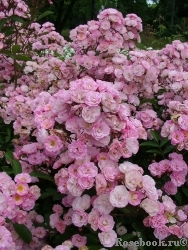 |
| Heavenly Pink |
Musk roses grow into fairly large bushes with gracefully drooping shoots. They are very good when planted alone on the lawn (one bush or a small group of the same variety), and beautiful on the edge of a retaining wall. Some varieties can be used as climbers on small obelisks. The varieties of this group look absolutely stunning when grafted onto a trunk, where the drooping branches form a “weeping” tree. And, of course, they can be planted in a mix with perennials: the flowers of most varieties have a delicate color - cream, pink, often with copper or apricot tones - and go well with other plants.
Finally, almost all musk roses are very unpretentious, hardy and resistant to disease and frost, and, in addition, grow well on their roots - in the Louis Lens nursery musk varieties In addition to grafting, they are also propagated by cuttings, obtaining more durable bushes.
Care
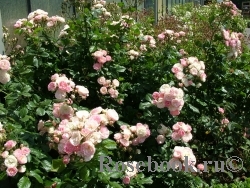 |

